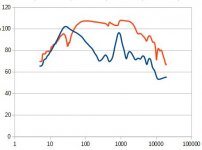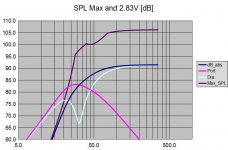Hi Everyone,
Thanks for all the help, including, of course, ernperkins who was the first to spot it.
I completely agree with everyone who says my plots don't look right. I'll upload the raw data in a little while, but I want to keep an open mind as to what "right" should be, and if I'm totally wrong would like to prove myself wrong via experimentation. Here's how I ended up "leaving the reservation":
When we evaluate a measurement technique we usually do so with the idea that far-field is messy, but king. The reason for the esteemed Mr. Bagby's blender and baffle step modifications to the near-field are to match up one to the other. And many have proven this works reliably. Myself included, though I may not bother at times. 🙂
We assume that all of the wiggles below that are room issues. Here's my cognitive dissonance. I've never seen a real ported speaker end up measuring in the far field like the textbooks, at or below port resonance. ernperkin's plots are an example of the current state-of-the-art technieques. I would love help being guided back to the land of reason and physics. 🙂
So it boils down to this: I did something different and it is matching up far better to the far-field. Help me come to grips, please.
Best,
E
Thanks for all the help, including, of course, ernperkins who was the first to spot it.
I completely agree with everyone who says my plots don't look right. I'll upload the raw data in a little while, but I want to keep an open mind as to what "right" should be, and if I'm totally wrong would like to prove myself wrong via experimentation. Here's how I ended up "leaving the reservation":
When we evaluate a measurement technique we usually do so with the idea that far-field is messy, but king. The reason for the esteemed Mr. Bagby's blender and baffle step modifications to the near-field are to match up one to the other. And many have proven this works reliably. Myself included, though I may not bother at times. 🙂
We assume that all of the wiggles below that are room issues. Here's my cognitive dissonance. I've never seen a real ported speaker end up measuring in the far field like the textbooks, at or below port resonance. ernperkin's plots are an example of the current state-of-the-art technieques. I would love help being guided back to the land of reason and physics. 🙂
So it boils down to this: I did something different and it is matching up far better to the far-field. Help me come to grips, please.
Best,
E
Last edited:
Here are my raw data files.
I calculated the port contributions using XSim. I treated the port and driver as speakers, adjusting polarity, distance and level of the port until it matched the far-field measurements. Total cheat, and the phase angles never matched, but amplitude did, nearly exactly.
I calculated the port contributions using XSim. I treated the port and driver as speakers, adjusting polarity, distance and level of the port until it matched the far-field measurements. Total cheat, and the phase angles never matched, but amplitude did, nearly exactly.
Attachments
One more thing, absolute port and near field levels are not accurate! 🙂 Sorry. I had intended to use previous results to get absolute levels.
Lojzek, more or less. Port is on the rear, and behind tweeter instead of behind woofer. So I had to move the mic, turn speaker around, replace mic, adjust height.
I would be surprised if the room mattered at all for that though. 🙂
I would be surprised if the room mattered at all for that though. 🙂
Port appears not to be of minimum phase. Can you have omnimic calculate it separately and what math operations can you perform in general with it?
Good catch. OmniMic let's me at least add one FR to the other. I was able to add the baffle step calculations to the spliced FR to incorporate that.
Make sure that adding baffle step response to other measurement is done with a math operation of multiplication.
It appears to me that you didn't flip the phase of a port response by 180 deg and that is why you got a whole around 45 Hz.
It appears to me that you didn't flip the phase of a port response by 180 deg and that is why you got a whole around 45 Hz.
Last edited:
The easiest way to splice is to match woofer and port level at a point far enough below port tuning. Hard to do with yours. Look at keele's nearfield paper and you will find scaling factors based on area, but I suspect that won't work for these files because it is a vector sum and your measured phase looks strange, and your files don't have the same frequency resolution and the levels are very far apart, like 108dB or so....
I did a little vlookup magic and came up with this - your match before the vector sum should look something like this (probably +/- 3-5dB or so).
I did a little vlookup magic and came up with this - your match before the vector sum should look something like this (probably +/- 3-5dB or so).
Attachments
- Status
- Not open for further replies.
- Home
- Loudspeakers
- Multi-Way
- Art of FR Splicing: SS 18W/4531

